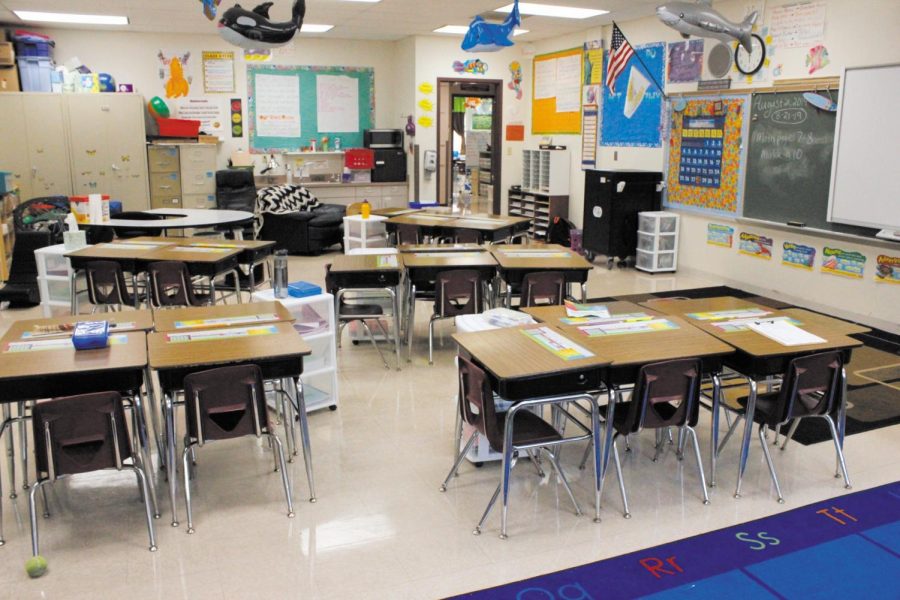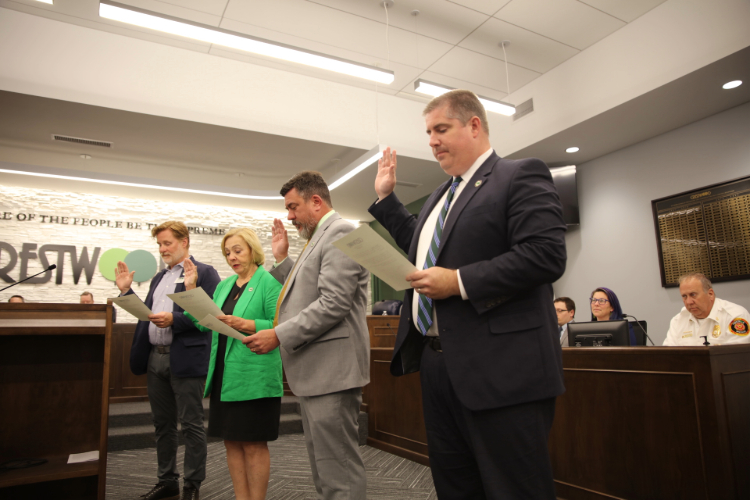A committee comprised of a cross section of the community will review the Lindbergh School District’s financial situation and formulate recommendations for the Board of Education to consider.
The Board of Education agreed during a special workshop session last week to establish the committee, which was requested by Pat Lanane, assistant superintendent for finance and the district’s chief financial officer.
Lanane’s request to establish the finance committee was made after board members reviewed the preliminary budget for the 2004-2005 school year.
Board members previously had asked Lanane to formulate a recommendation regarding the minimum reserve balance the district should maintain. During the roughly 3.5-hour work session on May 18, Lanane suggested the board maintain a minimum reserve balance of 25 percent of projected expenditures — a recommendation board members accepted during the meeting.
In his proposal, Lanane recommended the board remain consistent with the district’s past practice of keeping reserves at a level that would avoid the need to borrow money — even on a short-term basis.
“… There are really two pieces that are critical when you think about how much balance do you want to maintain. One is — and this is a longstanding principle that we’ve had — is to maintain a no-borrow budget (for) obvious reasons,” Lanane said. “Money used to pay the interest on loans is a terrible educational expense. No students benefit from that. No teachers benefit from that — only the bank and the lender benefit from that. So it’s been a longstanding thought to avoid borrowing if you absolutely can … What we have to do is we have to get through the months of July, August, September, October, November and part of December. Those are the months where our expenses clearly out run any revenue that’s coming in since we’re basically a property-tax based budget — 55 percent of it.
“So if we looked at that for this past year, that meant about $7.5 million that we had to have sitting there on July 1st to make it without borrowing. That’s about 17.5 percent of current expenditures. So I think that’s one piece of the answer …,” he said, noting that he believed a percentage approach is better than designating a dollar amount.
“The second piece of the formula has to do with, well, what else do you need? You know you want to cover cash flow, well, it’s emergencies — and there’s all kinds of emergencies,” Lanane said.
Among the emergencies he has seen throughout his career are: a state shortfall in taxes, catastrophic building failures, assessed valuation decreases, successful tax protests and runaway inflation, he told board members.
“… All kinds of things loom out there and I believe you’d want to have at least 7.5 percent in reserve in the event of any of those emergencies,” he said, noting that bond market and credit rating organizations review the reserve balance. “This is an important number that they look at when they rate your district to rate your bonds. I think if you dip below that 25 (percent), they’re going to get real — they’re actually real concerned now with watching that go down. That’s how closely they watch it. They haven’t downgraded us, but I would think that once we get to this 25 percent, I think that’s going to be kind of a magic number they’re going say: ‘Oh, this is serious.”’
While the reserve fund balance at the end of the current school year is anticipated to be at roughly 50 percent of expenditures, that amount is projected to drop to the 25 percent level at the end of the 2006-2007 school year, according to the assistant superintendent.
“… You’re starting to get close to this 25 percent figure that we’re talking about. That’s what I would recommend as a bare minimum (25 percent) … one of those warning signals that says it’s time to make either some drastic reductions in your expenditures or look for an increase in your revenue,” Lanane said.
In response to a comment from Board of Education President Mark Rudoff, Lanane said, “… When you look at that gap in annual revenues vs. the annual expenditures, what’s that gap? The gap is then what has to be covered by a tax increase. When does that get so large that the voters simply will say: ‘No, that’s too much.’ We’ve seen that in a few districts where it was, you know, a dollar or something that they were asking for. That’s not modest. And then the other trigger then is: ‘Uh-oh, our reserves have reached a point where we really don’t want to go below.
“So I think establishing both of those numbers is extremely important. Obviously, the board has their prerogative to set the balance exactly where they want it,” he said, adding, “I also think it would be a very good idea … to bring our community in, get a cross section and begin asking them also what about, when do you think a tax increase is going to be prudent? When you do think that we’re at a point where it’s palatable? When have we waited too late — some of those questions so that we can then bring back a recommendation to this board on really the second point.
“We have the balance point out there. My recommendation is 25 percent; the board may decide it’s 30 (percent). It may want to be more conservative than I am, but then I’d like to get a recommendation to you all to consider on the second point: When is that gap at the point when we need to address it with a tax increase?” Lanane said, adding that he was seeking the school board’s authorization to establish a finance committee.
Board members accepted Lanane’s recommendation to maintain a minimum reserve balance of 25 percent of projected expenditures and to establish a committee to review the district’s finances and make recommendations to the board.
The board president noted that the district already is looking at a nearly 21-cent difference between projected expenditures and anticipated revenues.
“… We’re already staring at the 20-cent differential right now — right now we’re staring at 20 cents, probably closer to 21 (cents) behind just based upon where we start next year …,” Rudoff said.
For the current school year, the board approved budget reductions totaling $1.9 million and is considering roughly $725,000 in budget reductions this year, although not all the budget reductions proposed by the administration were accepted by the board, Rudoff said.
“There’s going to come a point in time where we’re not going to be able to say no … The next set of cuts are going to be extraordinarily painful,” Rudoff cautioned.



















